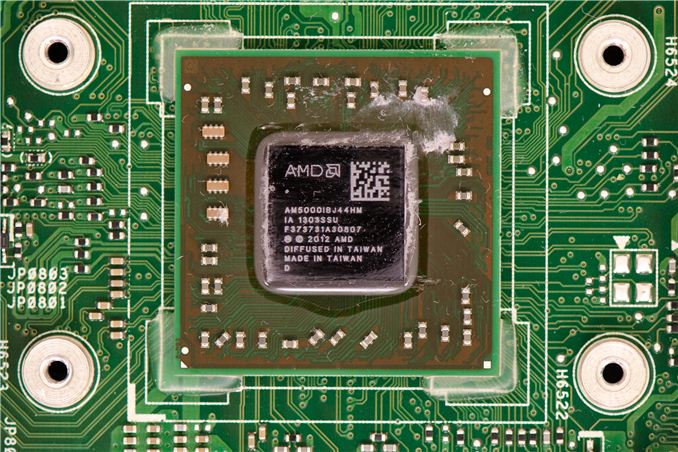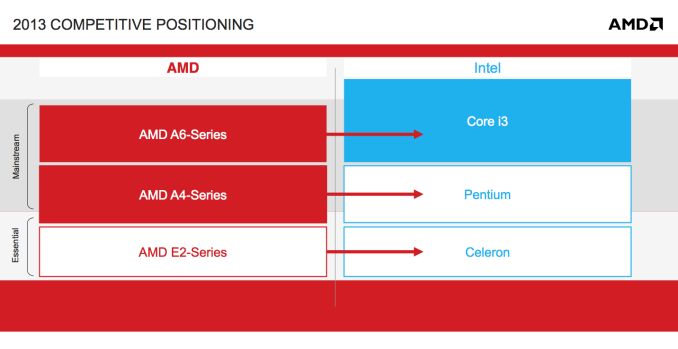The Kabini Deal: Can AMD Improve the Quality of Mainstream PCs with Its Latest APU?
by Anand Lal Shimpi on May 24, 2013 1:45 PM EST
There are two non-negotiables in building a PC these days: the cost of Intel silicon and the cost of the Windows license. You can play with everything else but Intel and Microsoft are going to get their share. Those two relatively fixed costs in the PC bill of materials can do one of two things: encourage OEMs to skimp on component cost elsewhere, or drive the entire ecosystem to supply higher quality components at lower prices. If you’ve been following the PC industry for the past decade, I think we’ve seen more of the former and less of the latter.
Apple occupying the high-end of the notebook PC space has forced many OEMs to reconsider their approach, but that’s a more recent change. What AMD seems to offer is an easier path. AMD will take less of the BoM, allowing OEMs to invest those savings elsewhere - a move Intel will never make. Given how much pressure the PC OEMs have been under for the past few years, AMD’s bargain is more appealing now than it has ever been.
With Llano and Trinity, AMD’s story was about giving up CPU performance for GPU performance. With Kabini, the deal is more palatable. You only give up CPU performance compared to higher priced parts (you gain performance compared to Atom), and you get much lower power silicon that can run in thinner/lighter notebooks. Typically at the price points Kabini is targeting (sub-$400 notebooks), you don’t get pretty form factors with amazing battery life. AMD hopes to change that.
While AMD hasn’t disclosed OEM pricing on Kabini (similarly, Intel doesn’t list OEM pricing on its mobile Pentium SKUs), it’s safe to assume that AMD will sell Kabini for less than Intel will sell its competing SKUs. If Kabini’s die size is indeed around 107mm^2, that puts it in the same range as a dual-core Ivy Bridge. AMD can likely undercut Intel a bit and live off of lower margins, but there’s one more component to think about: Ivy Bridge needs its PCH (Platform Controller Hub), Kabini does not. As a more fully integrated SoC, Kabini’s IO duties are handled by an on-die Fusion Controller Hub. Intel typically charges low double digits for its entry level chipsets, which is money AMD either rolls into the cost of Kabini or uses as a way of delivering a lower total cost to OEMs.
Traditionally, OEMs would take these cost savings and pass them along to the end user. I get the impression that AMD’s hope with Kabini is for OEMs to instead take the cost savings and redeploy them elsewhere in the system. Perhaps putting it towards a small amount of NAND on-board for a better user experience, or maybe towards a better LCD.
As we found in yesterday’s article, Kabini does a great job against Atom and Brazos. However, even with double digit increases in performance, Kabini is still a little core and no match for the bigger Ivy Bridge parts. Much to our disappointment, we pretty much never get sent low end hardware for review - so to make yesterday’s NDA we had to stick with 17W Ivy Bridge and extrapolate performance from there. In the past day I grabbed an ASUS X501A system, a 15-inch entry-level machine priced in the low $300s. More importantly, it features a 35W Ivy Bridge based Pentium CPU: the dual-core 2020M.
The Pentium 2020M’s base clock speed is still relatively high at 2.4GHz, but there’s no turbo. In the low level CPU performance analysis yesterday I used a Surface Pro with a 17W 1.7GHz Core i5, but max turbo on that part can hit 2.6GHz. I actually don’t expect there to be huge CPU performance differences between the results from yesterday and what I have here but I wanted to be sure.
The bigger difference is actually on the GPU side. While a mobile Core i5 comes with Intel’s HD 4000 graphics, the Pentium 2020M gets a vanilla Intel HD GPU. At 22nm, Intel’s HD graphics is a 6 EU part with lower performance than the previous generation Intel HD 3000.
With that said, let’s see how Kabini (AMD’s A4-5000 in particular) compares to an Ivy Bridge based Pentium 2020M in CPU performance, GPU performance and finally in power.











108 Comments
View All Comments
FwFred - Sunday, May 26, 2013 - link
Same area == less transistors, and higher power per transistor when comparing Intel's best to GF or TSMC's best. If the costs are similar, an AMD chip will be worse--less performance due to less transistors--so it will have to price it lower. It's design teams are at a distinct disadvantage, so AMD is forced to focus on seams in Intel's product lineup. Not an enviable position.casteve - Saturday, May 25, 2013 - link
Would love to see HQV scores for this device.Beenthere - Saturday, May 25, 2013 - link
Those who don't understand Anand's analysis aren't qualified to even make comments on Kabini vs. Intel. The bottom line is once again AMD is offering more than intel and for substantially less cost. More in this case equals:1. Better user experience
2. Better run time/longer battery life
3. Better grahics performance by a huge amount
4. Better price
5. Potential for better display or SSD
xenol - Saturday, May 25, 2013 - link
At first I saw the benchmark numbers and went "so what's AMD trying to prove here?" But then I saw the power consumption and went ô_o.Similar performance for a lot less power? That's good news for mobile devices.
thebeastie - Sunday, May 26, 2013 - link
I hope to see this SoC in the next version of HPs popular Microserver, or even something that is so cheap mb+Kabini combo that I can build a comparable sized and priced HP Microserver.duploxxx - Monday, May 27, 2013 - link
nah HP has fallen again for the Intel pressure and has chosen for a sandy in the next generation Gen8 of microservers, which will make it offcourse again way more expensive.Klimax - Sunday, May 26, 2013 - link
Too little too late. They have few weeks till Haswell (Upper limit) and a quarter or two till new Atoms. (Lower limit) Not sure if there will be much left after that.ddriver - Sunday, May 26, 2013 - link
It will still fit its niche, baytrail will still be slower, albeit a bit more efficient, and haswell will be way more expensive. Intel likes their profit margins high, even on low end products, baytrail has good chances of being more expensive. The profit margin for AMD is much thinner, they are just happy to move some product.kyuu - Monday, May 27, 2013 - link
Haswell is not going to compete on price, and the jury is still out on how low it will be able to scale power-wise since we have not seen any actual review hardware for ULV Haswell.As far as Atom... we have a lot of promises but Intel has yet to show any ability to do anything worthwhile with Atom. Even assuming Bay Trail lives up to promises, in a quarter or two AMD will be well on its way to releasing improved Jaguar-based silicon.
Hector2 - Tuesday, May 28, 2013 - link
I bought a full sized $280 15.4" Lenovo laptop on sale several months ago. It has a Intel Sandy Bridge 2.4GHz i3 dual core with 4M of memory. I'm really happy with the performance and thrilled about the price. Very tough to beat this price/performance